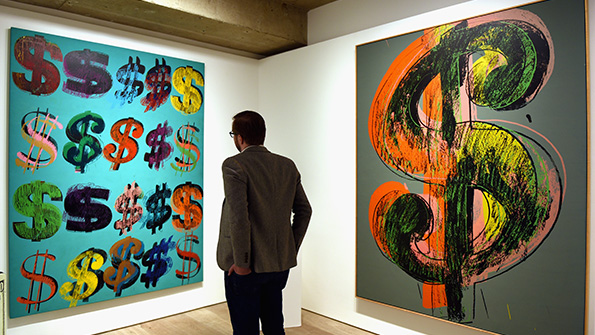
(Bloomberg) — A wealthy client at Bank of America Corp. put up his fine-art collection so he could borrow enough to buy a sports franchise. Another posted his cache of 19th century American landscapes to renovate his estate.
Such is the burgeoning world of art lending — where pieces are used to secure loans, allowing their affluent owners to tap their collections for cash without having to part with prized possessions. Art sales have slowed, forcing many to reevaluate their options. The major May New York auction season fell about 23% by value from the prior year, with the world’s richest waiting on the sidelines to buy.
“If you’re an owner and need liquidity now, you pause on selling, and instead borrow against your art, waiting for better market conditions,” said Adriano Picinati di Torcello, global art and finance coordinator for Deloitte. That’s contributing to the growth of the art-lending market, he said.
As the market expands, Wall Street’s biggest firms are growing their efforts by adding staff and marketing the service to new and existing clients. While the precise size of the market isn’t certain, Deloitte estimates outstanding loans against art could surpass $36 billion in 2024, up from $29 billion to $34 billion last year. That also compares with $20.3 billion to $23.6 billion of such loans outstanding five years ago, according to Deloitte.
The largest US banks are looking to broaden their reach into the art market as a way to bring on and retain some of the world’s wealthiest individuals and families. Catering to the affluent often means competing with rivals to offer more diverse products, fighting the constant threat that clients can move their money elsewhere.
Art lending offers specific advantages for wealthy owners evaluating their investments as broader financial markets face volatility. Unlike stocks, art isn’t subject to daily swings and is valued annually.
“We’re not asking what the value of your Andy Warhol is every day,” said Katy Lingle, US head of lending solutions at JPMorgan Chase & Co. Private Bank.
The global art market has cooled from record-high valuations coming out of the pandemic. Even as sales have slumped and values have pulled back, demand for art loans is there.
Read More: Top of the Art Market Appears to Be Crumbling
Bank of America has seen new credit lines backed by art rise more than 14% compared to a year ago, according to Drew Watson, head of art services. Its book of art loans recently hit its highest on record. Within JPMorgan’s asset and wealth management business, art lending is up 1% year-over-year, in-line with other loans in that business, according to a spokesperson.
“Even in a higher rate environment, people are still taking advantage of timely opportunities,” taking out loans on their art over selling it at a discount, or selling stock, Watson said.
Bank of America, since it formed its art services group in 2017, has grown to capture over 30% market share, according to a spokesperson. The team, which the bank is continuing to invest in, has 12 specialists in the art market across credit, wealth planning and philanthropy. The bank’s clients that already have loans keep them, while utilization has remained around 70% this year, according to Watson.
“The retention and strong utilization is reflected in the balances outstanding, which have remained strong,” he said.
Bank of America structures these loans on a variable rate, so over time the cost of capital could decrease if rates fall. The interest rate is based on the secured overnight financing rate, plus a spread, Watson said. So as rates get cut, loans like this are even more likely to increase.
Citigroup, which estimates its share of the market at 10% to 15%, has a steady base of art-lending clients because rates on art loans are still favorable compared to other loans, according to Fotini Xydas, head of art finance at Citi Private Bank.
“Even though rates are higher, art is a very stable asset over the long term, compared to other assets in terms of volatility,” she said.
Art loans function as lines of credit, so clients draw on them and pay them back as they can. They’re only available to the wealthy, given the nature of the collateral. The larger the collection, the more flexibility there is for the borrowers.
Read More: At Art Basel, The World’s Richest Are Taking Their Time To Buy
To qualify at Bank of America and Citigroup, a collection usually needs to be worth at least $10 million, which secures a loan of $5 million or more. Bank of America typically offers 50% loan to value, with each piece worth a minimum of around $100,000. The terms run from around one to three years, with an option to renew, and clients can still keep their pieces protected at home as long as its within the US. Citigroup looks for a minimum value of $200,000 per piece.
JPMorgan bases its loan sizes on the value of the collection and strength of the borrower. The bank looks for diversity of pieces, ensuring they are of “museum quality,” Lingle said. It also does a financial analysis on borrowers to make sure they can service the debt.
One Citigroup client who had collected several pieces from Pablo Picasso and Claude Monet used them to secure a line of credit to cover taxes tied to estate planning, another common use of this product.
Another private equity principal wanted a line of credit to help fund a capital call. Bank of America facilitated a $10 million loan for one borrower worried about market volatility, using his collection of post-war and contemporary art as collateral.
“There are margin calls, death, divorce and bankruptcy, so we have endless interest for lending,” said Philip Hoffman, the founder of The Fine Art Group, an art advisory and finance specialist that competes with the banks.
This post was originally published on this site be sure to check out more of their content





